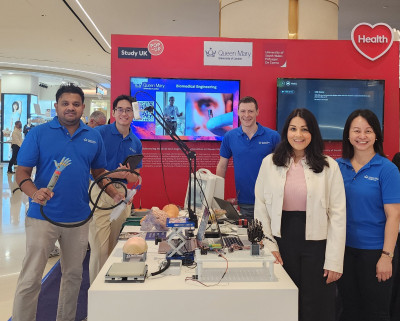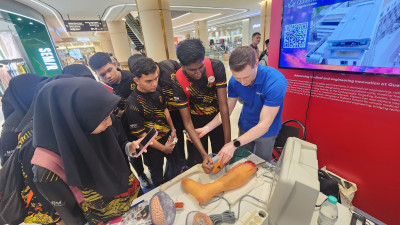News
Malaysia visit promotes Queen Mary’s innovations in medical technology
4 March 2025


In late February, a team from Queen Mary University of London travelled to Malaysia to demonstrate our innovative research in medical technology, at an event organised by the British Council.
Dr Thilina Lalitharatne, Lecturer in Robotics and Mechatronics, and Dr Stefaan Verbruggen, Lecturer in Medical Technology, joined Dr Andrew Spowage, who supports the School of Engineering and Materials Science’s China campus, for a four-day exhibition at the Sunway Pyramid Shopping Mall, Petaling Jaya.
The 'Pop Up Study UK' event, designed for school-age students and their families, offered hands-on demonstrations showcasing the future of innovation across the categories of engineering, health, sports and art and design. Styled like a museum exhibit, the event focused on immersing visitors in the creativity, impact, and excellence of UK universities, rather than promoting study opportunities. The British Council Malaysia described the event as: “an opportunity to see, feel, and experience the excellence of UK universities firsthand."
Siewmang Yee, Regional Manager for South East Asia at Queen Mary, explained: “In Malaysia, as in many other Asian countries, students often gravitate towards studying law or medicine due to societal and family influence. By showcasing biomedical engineering, the week highlighted how engineering students can make a meaningful impact in the medical and healthcare sectors.”
The Queen Mary team demonstrated a variety of medical technology developed by our researchers, including:
- Organs-on-chips:
Organ-chips are small, bioengineered devices containing living cells, that mimic the behaviour of human organs. These devices offer a promising alternative to traditional pre-clinical models, which often struggle to accurately predict human responses to drugs, leading to high costs, lengthy development times, and limited treatment options for patients.
- Orthopaedic targeting system for intramedullary nails:
Assisted by electromagnetic navigation, the digital targeting system provides real-time guidance for accurate screw placement in orthopaedic procedures. Queen Mary’s biomedical and robotics engineers have developed a practical targeting arm that digitally represents screw hole positions, with software processing real-time data for precise on-screen guidance, meeting the practical demands of the operating room.
- Myoelectric prosthetic hand:
Demonstrating how signals from user’s muscles can control a prosthetic hand in real-time.
- Soft robotic hand:
This silicone rubber prosthetic hand features integrated air chambers that, when pressurised, initiate finger movement, allowing the device to function like a natural hand.
- Robotic patient for remote medical examinations and training:
A robotic physical twin of a patient, for remote medical examination training, specifically focused on palpation. It consists of a robotic face to mimic the facial expressions of patients from different ethnic and gender backgrounds, as well as an auditory expression system to simulate patients' pain vocalizations, producing an ‘ouch’ sound if pressed too hard.
While they were in Malaysia, the team also delivered guest lectures and workshops at several secondary schools, and attended an alumni reception, attended by nine engineering alums.
Last year, the UK was the top choice study destination for students from Malaysia (British Council’s Study UK survey 2023/24, State of Student Recruitment 2024).
| Contact: | Ayden Wilkes |
| Email: | a.wilkes@qmul.ac.uk |
| People: | Stefaan VERBRUGGEN Thilina DULANTHA LALITHARATNE Andy SPOWAGE |




